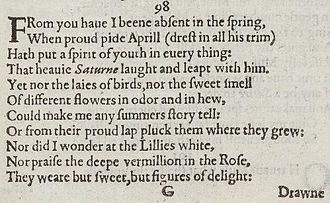Paraphrase
We were apart during the spring, when everything feels young, even aged Saturn; however, none of the beauty I saw around me could bring me into sympathy with my surroundings. I could not admire the lily or the rose, since these were to me only images of you. Thus, it still seemed winter to me, since you were away.
Structure
Sonnet 98 is an English or Shakespearean sonnet. The English sonnet has three quatrains, followed by a final rhyming couplet. It follows the typical rhyme scheme of the form, ABAB CDCD EFEF GG, and is composed in iambic pentameter, a type of poetic metre based on five pairs of metrically weak/strong syllabic positions. The 4th line exemplifies a regular iambic pentameter:
× / × / × / × / × / That heavy Saturn laugh'd and leap'd with him. (98.4)
- / = ictus, a metrically strong syllabic position. × = nonictus.
The 12th line potentially exhibits two metrical variations: first, an initial reversal, second, the rightward movement of the fourth ictus (resulting in a four-position figure, × × / /, sometimes referred to as a minor ionic):
/ × × / × / × × / / Drawn after you, you pattern of all those. (98.12)
The same variations, in the same positions, are also potentially present in line 5. However, if the repetition of the word "nor" draws special emphasis from the reader, both positions would be affected, resulting in the somewhat more regular:
× / × / × / / × × / Yet nor the lays of birds nor the sweet smell (98.5)
The meter demands a few variant pronunciations: line 3's "spirit" is one syllable (possibly pronounced as spear't, sprite, sprit, or spurt [2] ), line 6's "different" is two syllables and "flowers" is one.
This page is based on this
Wikipedia article Text is available under the
CC BY-SA 4.0 license; additional terms may apply.
Images, videos and audio are available under their respective licenses.


